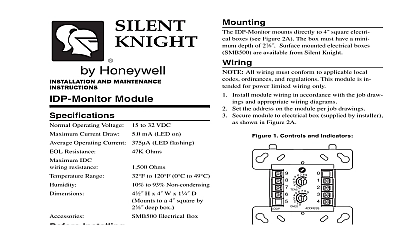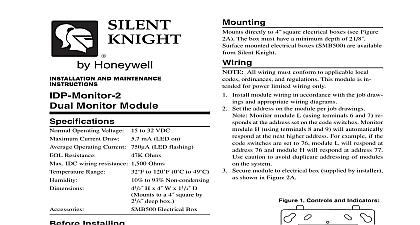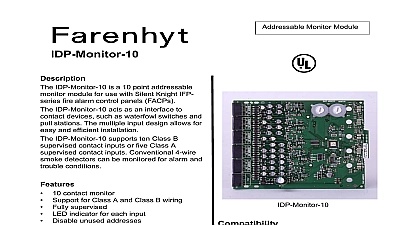Silent Knight IDPmonitor10 isheet

File Preview
Click below to download for free
Click below to download for free
File Data
| Name | silent-knight-idpmonitor10-isheet-1243867950.pdf |
|---|---|
| Type | |
| Size | 795.45 KB |
| Downloads |
Text Preview
sory supply and ground Otherwise each monitor oper independently from the others Each module has its unique address pair of rotary code switches is used to set the address the first module from 01 to 90 The remaining modules automatically assigned to the next nine higher ad Provisions are included for disabling a maximum two unused modules to release the addresses to be elsewhere Each module also has panel controlled LED indicators The panel can cause the LEDs to latch on or latch off on Board Shunt in Class A B position in Class B position remove shunt for Class A 1 x 4 Terminal Blocks 2 11 4 32mm Stand offs Machine Screws 3 Shunts 10 47k Ohm of Line Resistors Nuts REQUIREMENTS ensure proper operation this module shall be con to a compatible Silent Knight system control panel following is a description of the IDP Monitor 10 framework One or two IDP Monitor 10 modules can be IDP ACB cabinet has a built in chassis that will ac one or two IDP Monitor 10 modules in a IDP ACB cabinet 1 IDP ACB Cabinet front IDP Monitor 10 module positions of each chassis offset below the rear IDP Monitor 10 module positions that all of the status indicators are visible For cabinet refer to the IDP ACB instruction manual AND INSTRUCTIONS Input Monitor Module Ohms Ohms VDC each circuit mA mA assumes all ten solid on to 120 0 to 49 to 93 Non condensing H x 5.8 W x 1.25 D Cabinet and Chassis AWG Operating Voltage 15 32 VDC Current Current Range Gauge SLC Resistance IDC Resistance IDC Voltage IDC Current INSTALLING the modules will be installed in an existing operational inform the operator and local authority that the will be temporarily out of service Disconnect the to the control panel before installing the modules system contains static sensitive components Always yourself with a proper wrist strap before handling circuits so that static charges are removed from the The housing cabinet should be metallic and suit grounded This manual should be left with the owner of this equipment DESCRIPTION IDP Monitor 10 Ten Input Monitor Module is in for use in an intelligent alarm system Each moni module is intended to interface between a control and normally open contact devices such as pull A common SLC input is used for all modules the initiating device loops share a common supervi STEPS Cabinet Mounting a clean dry area mount the backbox using the holes provided in the back surface of the cabinet 2 4a Installation of IDP Monitor 10 module in a chassis position method two 1 Insert the bottom edge of the IDP Monitor 10 down into a rear slot of the chassis 2 Carefully swing the upper edge of the board the back of the chassis until it touches short standoff attached to the chassis 3 Align the long standoff with the short stand off tighten 4b Installation of IDP Monitor 10 module in chassis position 1 Insert the bottom edge of the IDP Monitor 10 down into a front slot of the chassis 2 Carefully swing the upper edge of the board the back of the chassis until it touches 11 31.75mm standoffs installed on the module 3 Align two 4 40 screws with the two standoffs tighten 4 Address and wire the modules according to the in this manual 2 Typical mounting hole locations Module Installation There are two methods for installing a module in the position of a chassis Method one is for installa of a rear module only when no module will be in in front of it Refer to Figure 3 for instructions two is for installation of a rear module when module will be installed in the chassis position front of it Refer to Figures 4a and 4b for method All necessary screws and standoffs are supplied the modules 3 Installation of rear module only method one 1 Insert the bottom of the IDP Monitor 10 module into a rear slot on the chassis 2 Carefully swing the upper edge of the board towards the back of the chassis until it the two standoffs 3 Align two 4 40 screws with the two standoffs tighten 4 Address and wire the modules according to the in this manual steps in Figures 4a and 4b describe and illustrate mod installation when the rear chassis position and the posi in front of it will be filled Front position installation possible only if the rear position is filled with a module All wiring must conform to applicable local ordinances and regulations Install module wiring in accordance with the job draw and appropriate wiring diagrams All wiring to the IDP Monitor 10 is done via terminal In order to properly make electrical connec strip approximately 1 of insulation from the of wire sliding the bare end of the wire under the plate screw Set the address on the modules per the job drawing Use rotary code switches to set the address of the first between 01 and 90 Class B operation the remaining modules are automati assigned to the next nine higher addresses For if the base address switch is set to 28 the next modules will be addressed to 29 30 31 32 33 34 36 and 37 module is shipped in Class B position remove for Class A When operating in Class A alternate are paired together 0 1 2 3 4 5 6 7 resulting in a total of five modules For example the base address switch is set to 28 then 30 32 34 36 will be automatically assigned to the modules 29 31 33 35 and 37 are available to be used for modules on the SLC For Class A and B operation NOT set the lowest address above 90 as the other will be assigned to nonexistent addresses The IDP Monitor 10 must have power cycled for changes to take effect A shunt is provided to disable a maximum of two un modules in Class B operation and one unused in Class A operation Modules are disabled the highest address and work downward If two are disabled the lowest eight addresses will functional while the highest two will be disabled example in Class B operation if the shunt for Disable is placed on and the base switch set to 28 the modules will be assigned to 28 29 30 32 33 34 and 35 while disabling the highest two A communications loss feature is available on some Upon a communication loss due to a micro failure at the control unit the IDP Monitor will send a signal to the control unit to activate the device circuits upon initiating of an alarm the IDP Monitor 10 A single shunt is used to en shunt on or disable shunt off this feature for all on the board Place unused shunts on single pin to store on for future use NOTES Power limited circuits must employ type FPL FPLR or FPLP cable as required by Article 760 of the NEC modules are programmed as devices in each system to the programming instructions in the appro FACP manual Statement device complies with part 15 of the FCC Rules Operation is subject to the following two conditions 1 This device may not cause harmful in and 2 this device must accept any interference received including interference that may cause undesired operation This equipment has been tested and found to comply with the limits for a Class B digital device pursuant to Part 15 of the FCC Rules limits are designed to provide reasonable protection against h


